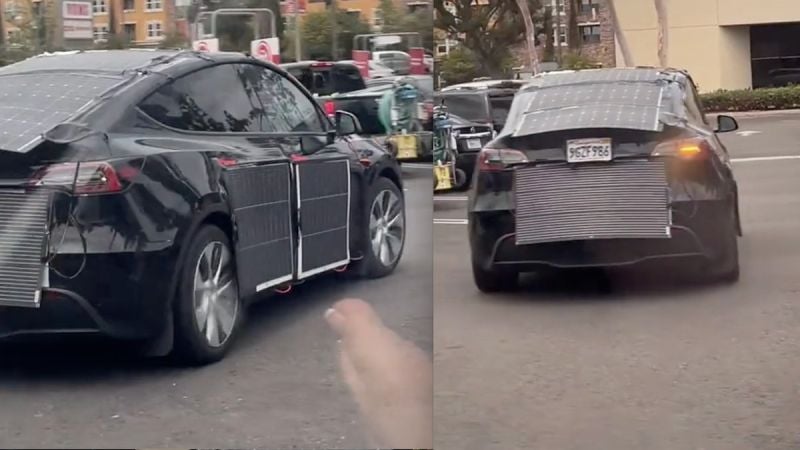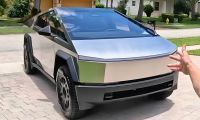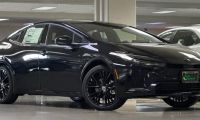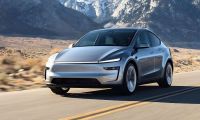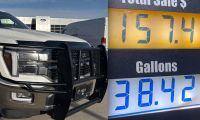Can you charge a Tesla Model 3 by using solar panels? What if you attach them directly to the car's body panels?
Sandra (@sandraaaa096) in her TikTok video clip shows a Tesla Model 3 driving through a parking lot with solar panels strapped to the car's exterior. Do they really work to charge the car using the sun's energy, for free? Sandra thinks it's because the economy is bad.
She says, "The economy is so bad, Teslas now have solar panels strapped on."
Imagine living in California, where in some cities, they get a significant amount of sunshine, with many cities experiencing over 300 days of sunshine annually. It's the ideal place to use solar energy and capture the sun's power.
Picture yourself shopping, driving into a parking lot, and seeing a Tesla Model 3 with solar panels attached to the electric car's rear, sides, and roof. It looks cartoonish. You can't believe what you see, and grab your phone and start recording.
What would you think?
Sandra thinks the economy must be so bad that Tesla owners can't even afford to recharge their electric cars' batteries. She might be right because charging a Tesla Model 3 or any EV in California is often more expensive than in other parts of the U.S., according to a report by Bloomberg.
The report says public charging is higher than home charging, and electricity rates in California have risen significantly, impacting the overall cost for home charging as well.
Does this Model 3 owner, Sandra, who she recorded with solar panels attached to their car, know something no one else does?
Does attaching solar panels directly to an electric vehicle like a Tesla Model 3 work?
While this Tesla Model 3 owner has a great idea in theory, it doesn't work in the real world. Reports from PPM Solar and EV.Morek says, you can't just plug an electric vehicle into a solar panel and expect it to work.
EV.Morek says, "There is more to it than just simply plugging your EV charging station into solar panels directly. The problem is that the power generated by a photovoltaic panel is uneven and highly variable and cannot be fed into an EV's battery (or the electricity network) directly.
You Need an Inverter To Use the Solar Power
The report says, "In any case, any solar panel installation needs to have an inverter installed to convert the electricity so it can be fed into the electricity network at home and used to power appliances or charge your car."
Here is how it works:
Solar panels convert sunlight into electricity, powering your home and charging your EV. A solar inverter converts the DC electricity from the panels to AC electricity needed for EV charging.
- Benefits: Charging your EV with solar panels provides "free" electricity (after the cost of the solar panels and the cost of the equipment) to significantly reduce electricity costs, reduce your carbon footprint, and help mitigate potential energy price increases.
- Setup: You'll need a solar panel system capable of generating enough electricity to power both your home and your EV charger. You may need to add more solar panels if your existing system doesn't have enough capacity.
- EV Charger Integration: You can use a standard Level 1 or Level 2 EV charger at home, and the solar panels can power either type. Some EV chargers, like the Tesla Powerwall (which can cost $15,000), are designed to work seamlessly with solar energy.
- Calculating Panel Needs: To determine the number of solar panels you need, consider your EV's monthly energy consumption, your panels' output, and the peak sun hours in your area.
What is the cost of a complete solar setup, including a Tesla Powerwall?
This Old House says, "Based on a secret-shopping quote we acquired on Tesla's website for a home near Austin, Texas, a single Tesla Powerwall 3 battery costs $16,779.
How Much Are Installation Costs?
This Old House says, "Installation costs vary depending on your installer, but our 2025 survey of 1,000 recent home solar customers revealed that the average price to install a Tesla Powerwall is $7,466. This pricing reflects the responses of 81 Tesla Powerwall customers across the United States."
What About Federal Tax Incentives?
The report says you can save thousands of dollars on a Tesla Powerwall by applying for solar incentives. "The federal solar tax credit is one of the most valuable incentives most homeowners qualify for. If you're considering a Tesla Powerwall, we recommend requesting a quote and comparing it to the price of other solar batteries."
Conclusion:
The Tesla Model 3 owner who Sandra spotted with solar panels strapped to their car to get free solar energy to power the electric vehicle while driving is a good idea. Still, it doesn't work without a lot of other equipment. You would need to haul a large trailer behind the car for it to be adequately equipped.
While there's an initial cost for the solar panels and installation at your home, the long-term savings from 'free' or reduced electricity can offset the investment. It's a long-term commitment that can lead to significant financial benefits over time.
How about you?
How do you charge your Tesla Model 3 or other electric vehicle? Do you use DC fast charging or Level 2 charging? Have you installed solar panels in your home? If so, click the red Add New Comment link below and share your experiences. We would like to hear from you if you have any advice or tips for others looking for a similar setup.
Check out my Tesla Model 3 story: I Won’t Ever Buy A Tesla Again, We Moved to An Apartment, It Takes Too Long To Charge, and Now Our New Model 3 Sits Most Of the Time
I am Denis Flierl, a Senior Torque News Reporter since 2012. My 30+ year tenure in the automotive industry, initially in a consulting role with every major car brand and later as a freelance journalist test-driving new vehicles, has equipped me with a wealth of knowledge. I specialize in reporting the latest automotive news and providing expert analysis on Subaru, which you'll find here, ensuring that you, as a reader, are always well-informed and up-to-date. Follow me on my X SubaruReport, All Subaru, WRXSTI, @DenisFlierl, Facebook, and Instagram.
Photo credit: Denis Flierl via Sandra



